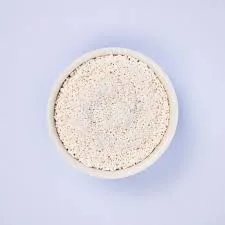
Exploring Innovative Solutions in SBR Chemical Applications and Advancements
Understanding SBR Chemical Properties, Applications, and Benefits
Styrene-butadiene rubber (SBR) is a synthetic rubber that combines styrene and butadiene, offering an innovative solution for various industrial applications. Developed in the 1930s, SBR has become one of the most widely used synthetic rubbers globally, particularly due to its favorable properties and versatility.
Properties of SBR
SBR possesses a unique combination of properties that make it suitable for a wide range of applications. Its excellent abrasion resistance ensures durability, particularly in applications that involve frequent wear and tear. Additionally, SBR has good aging stability, meaning it can withstand prolonged exposure to sunlight, ozone, and other environmental factors. This stability is critical for products that are used outdoors or in harsh conditions.
Another significant property of SBR is its flexibility and resilience. This elasticity allows SBR to return to its original shape after deformation, a crucial characteristic for tires and other dynamic applications. Furthermore, SBR can be easily compounded with fillers, plasticizers, and other additives, enabling the fine-tuning of its properties to suit specific requirements.
Applications of SBR Chemical
The versatile nature of SBR means it is employed across various industries. One of the most prominent applications is in tire manufacturing. SBR contributes to the performance characteristics of tires, such as traction, wear resistance, and fuel efficiency. The majority of tires on the market incorporate SBR in their formulation, making it a vital component in the automotive industry.
Beyond tires, SBR is extensively used in the production of footwear, particularly in the manufacture of soles. Its durability, flexibility, and comfort make it an ideal choice for high-performance footwear. Additionally, SBR is found in seals, gaskets, and other sealing products, where its resistance to aging and environmental factors is essential.
sbr chemical

SBR also plays a crucial role in the adhesive and coating industries. Its ability to form strong bonds and its compatibility with various surfaces make it a valuable ingredient in adhesives. As for coatings, SBR can be used in protective coatings that require resistance to water, heat, and other degrading agents.
Moreover, SBR is significant in the production of various household and industrial products, such as rubber bands, hoses, and conveyor belts. Its adaptability allows manufacturers to develop products that meet specific performance criteria, catering to the diverse needs of consumers and industries alike.
Benefits of Using SBR
The use of SBR brings numerous benefits to industries that rely on it. Firstly, its cost-effectiveness makes it an attractive option for manufacturers. The availability of styrene and butadiene as raw materials contributes to the relatively low production costs associated with SBR.
Secondly, SBR's mechanical properties can be tailored through compounding, allowing producers to create products that excel in performance while maintaining affordability. This customization adds significant value, particularly in competitive markets where product differentiation is essential.
Lastly, SBR's environmental compatibility is gradually being enhanced through ongoing research and development. Efforts are being made to create more sustainable production processes and formulations that minimize environmental impact, aligning with the growing global emphasis on sustainability.
Conclusion
In summary, styrene-butadiene rubber (SBR) is a vital synthetic material that plays a critical role across a range of industries. Its unique properties, including durability, flexibility, and resistance to harsh conditions, make it a preferred choice in various applications, from tires to footwear and adhesives. As industries continue to evolve and innovate, the ongoing development of SBR will likely lead to even more advanced applications, solidifying its status as a key player in the world of materials science.
-
Buy High-Quality Trichloroisocyanuric Acid for Sale | TCCA 90% SupplierNewsAug.30,2025
-
Pure Sodium Dichloroisocyanurate Dihydrate | Powerful DisinfectantNewsAug.29,2025
-
Industrial Chemicals: Quality & Purity for Every IndustryNewsAug.28,2025
-
Nitrile Rubber Honoring Strict Production StandardsNewsAug.22,2025
-
Aspartame Ingredients Honoring Food Safety ValuesNewsAug.22,2025
-
Fertilizer for Balanced Plant NutritionNewsAug.22,2025
-
Cyanide Gold Processing with High Purity AdditivesNewsAug.22,2025
Hebei Tenger Chemical Technology Co., Ltd. focuses on the chemical industry and is committed to the export service of chemical raw materials.
-

view more DiethanolisopropanolamineIn the ever-growing field of chemical solutions, diethanolisopropanolamine (DEIPA) stands out as a versatile and important compound. Due to its unique chemical structure and properties, DEIPA is of interest to various industries including construction, personal care, and agriculture. -

view more TriisopropanolamineTriisopropanolamine (TIPA) alkanol amine substance, is a kind of alcohol amine compound with amino and alcohol hydroxyl, and because of its molecules contains both amino and hydroxyl. -

view more Tetramethyl Thiuram DisulfideTetramethyl thiuram disulfide, also known as TMTD, is a white to light-yellow powder with a distinct sulfur-like odor. It is soluble in organic solvents such as benzene, acetone, and ethyl acetate, making it highly versatile for use in different formulations. TMTD is known for its excellent vulcanization acceleration properties, which makes it a key ingredient in the production of rubber products. Additionally, it acts as an effective fungicide and bactericide, making it valuable in agricultural applications. Its high purity and stability ensure consistent performance, making it a preferred choice for manufacturers across various industries.





